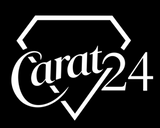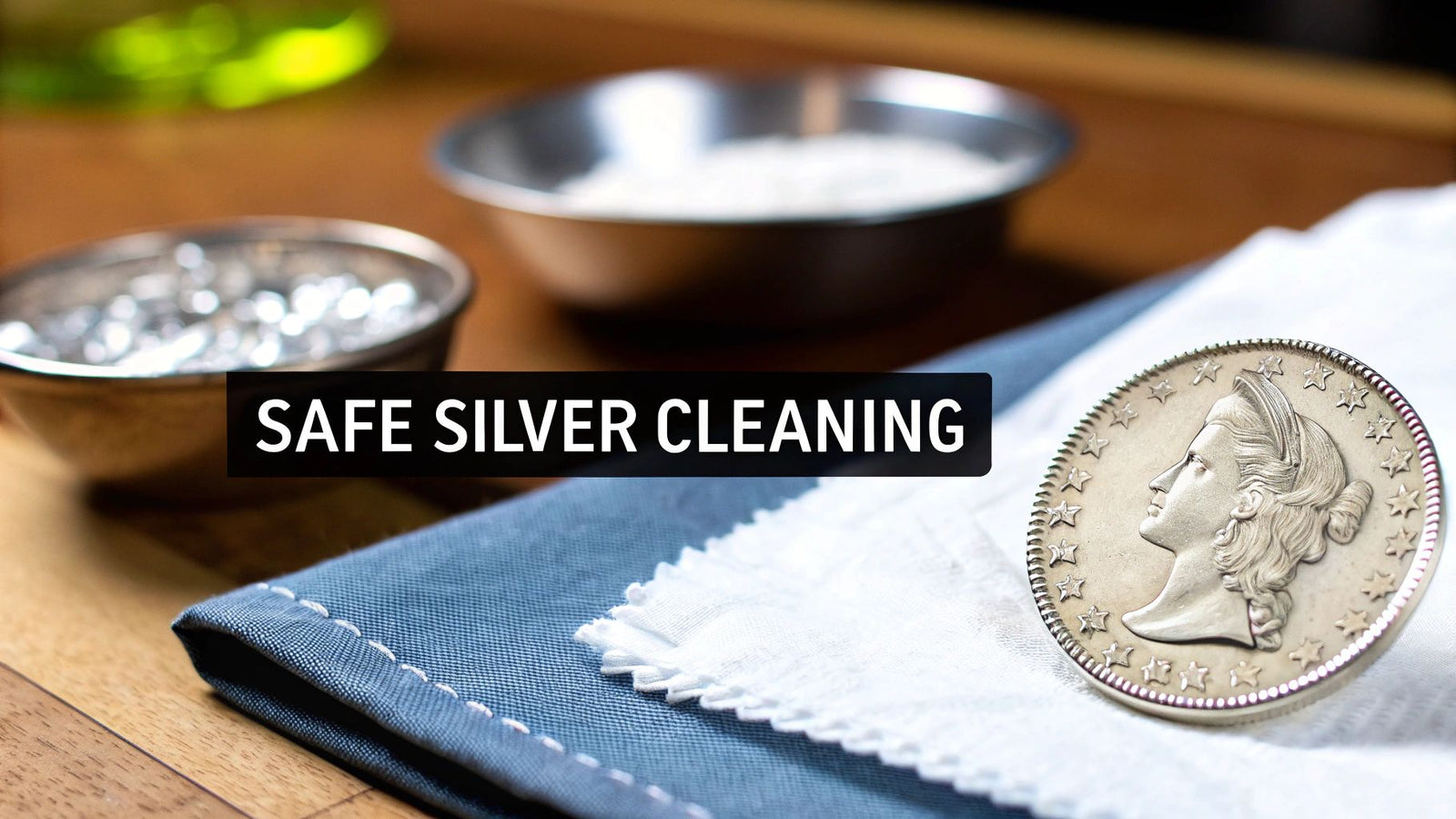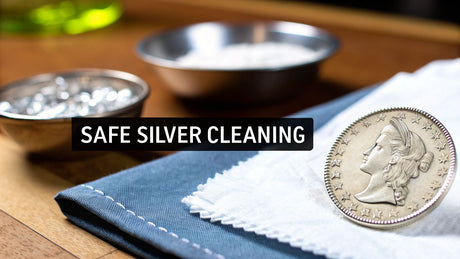Before you even think about how to clean a silver dollar, you need to ask a much more important question: should you?
For most collectors, the answer is a hard no. Cleaning a coin can permanently wipe out its historical and financial value. The first, most critical step is figuring out whether you're holding a common bullion coin or a rare collectible.
Should You Clean Your Silver Dollar?
It’s a natural impulse. You see a tarnished old silver dollar and you want to make it shine. But that's a move that nearly every numismatist (that's a coin expert) will tell you to avoid. A coin’s true value isn't in its gleam; it's locked up in its originality and history.
Cleaning, especially with anything abrasive, can erase hundreds or even thousands of dollars in value in just a few minutes.
So, before you do anything, you need to identify what you have. Is it a common piece of silver, or is it a piece of history? The difference is everything.
- Bullion Coins: These are typically modern coins valued almost entirely for their silver content. Their price is directly tied to the daily spot price of silver. The American Silver Eagle is a perfect example.
- Collectible (Numismatic) Coins: These are older, often rarer coins. Their value comes from their history, how few of them exist, and their condition. Morgan and Peace dollars frequently fall into this category, with specific dates and mint marks being incredibly valuable.
The Importance of Patina
That tarnish you want to scrub off? Collectors have a different name for it: patina.
Patina is the thin layer of toning that forms naturally on a coin's surface over decades. Think of it as the coin's historical fingerprint. It's proof of its age and authenticity. In fact, many experienced collectors will actually pay a premium for coins that have developed an attractive, even toning because it’s a clear sign of an original, untouched surface.
A coin’s surface is like a delicate historical document. Once you clean it, you’ve essentially erased part of its story, and that loss of information is irreversible. Professionals can spot a cleaned coin instantly, and its value plummets accordingly.
Real-World Financial Risks
Let's put this into real numbers. Imagine you inherit an 1893-S Morgan silver dollar. In a circulated but completely original, uncleaned condition, this coin could be worth over $50,000.
Now, imagine you give it a "quick polish" to make it look new again. What you've actually done is create thousands of microscopic scratches while stripping away its original surface. To an expert, it's no longer a valuable collectible. It's now just a "cleaned, damaged coin," and its value might crash to little more than its basic silver worth. You've turned a prized asset into a simple piece of metal.
Understanding the melt value is also part of the equation. To learn more about how precious metals are valued, our article explaining the worth of 5 oz of silver value provides great insight.
When considering selling any precious metals, including Gold and Jewelry Buying, finding a local buyer who offers the highest payout in Boise is key. You can save the hassle and sell locally for more than online shipments. Look for experts who provide Xray Scanning and Gold Testing for free to give you hassle free offers, and ask about Price Matching to ensure you're getting the best deal.
Safe Cleaning Methods for Non-Collectible Coins
Once you've confirmed your silver dollar isn't a rare collectible, you can look at a few ways to spruce up its appearance without causing damage. It's so important to remember that even for common bullion coins, aggressive cleaning can leave nasty, irreversible scratches. The goal here is to gently lift away grime and tarnish, not to strip the coin's surface down to bare metal.
We'll focus on two reliable, non-abrasive techniques that have been used by coin handlers for years. The first, and probably the most well-known, is a simple electrochemical process that uses items you likely already have in your kitchen. It’s effective because it works to reverse the tarnishing process itself, rather than just scrubbing the tarnish off.
This image shows the basic tools you’ll want to have on hand before you get started.
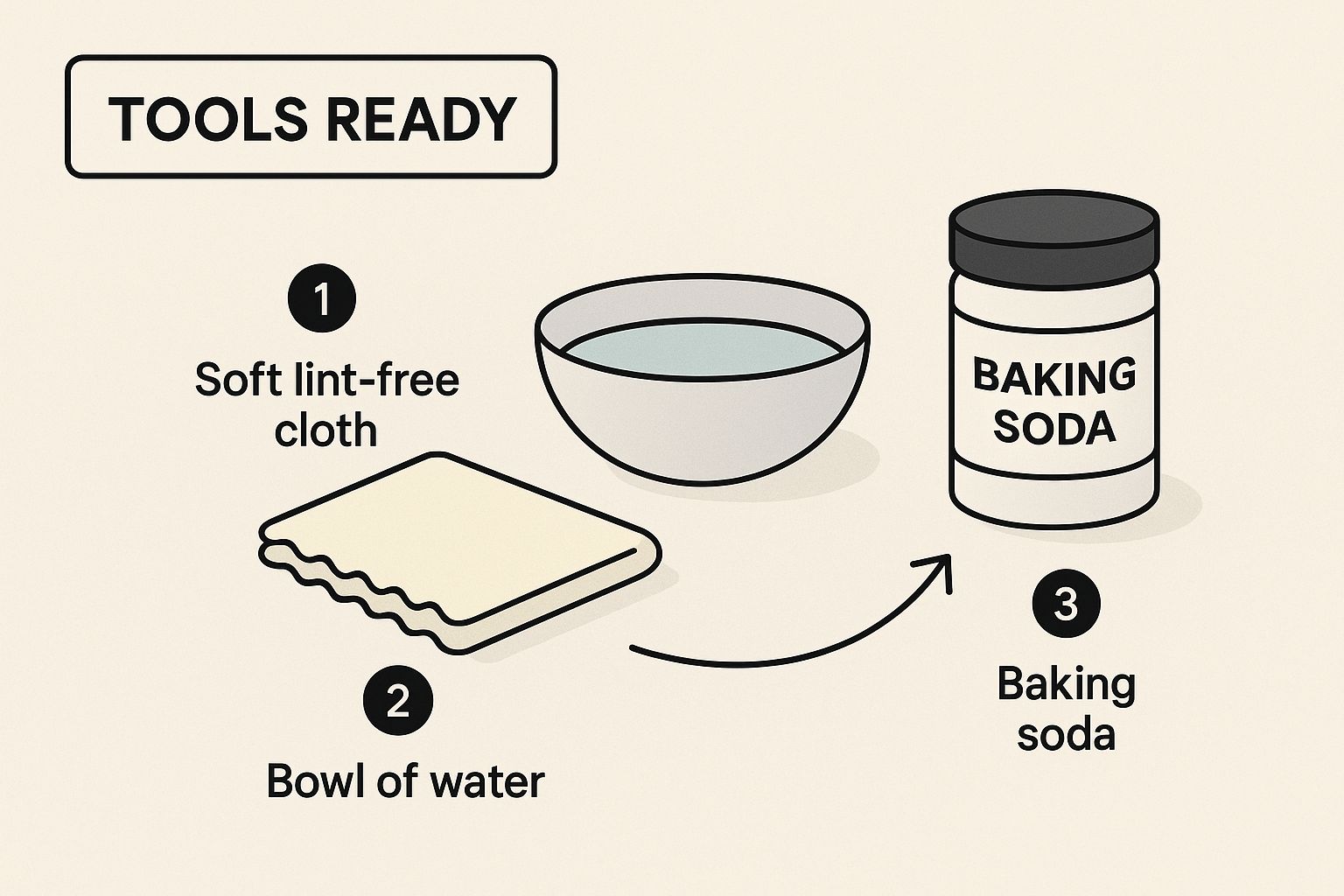
Having these simple materials ready makes the whole process go much smoother and stops you from reaching for something harsher that could damage your coin.
The Baking Soda and Aluminum Foil Method
This technique is a classic for a reason—it’s a bit of basic chemistry that works surprisingly well. It's one of the most effective home methods because it creates a gentle chemical reaction using aluminum foil, baking soda, and hot water.
Essentially, the process relies on electrochemistry. The aluminum acts as a catalyst, attracting the sulfur compounds (which is what tarnish is) away from the silver. This clever method chemically converts the silver sulfide tarnish back into metallic silver, preserving the coin’s original surface. It's a popular method discussed widely on community forums for treasure hunters and coin enthusiasts.
To give it a try, you'll need just a few things:
- A glass or ceramic bowl (never use metal for this)
- A sheet of aluminum foil
- Baking soda
- Boiling distilled water
- A non-metal utensil, like plastic tongs or a spoon
Start by lining the bottom of your bowl with the aluminum foil, making sure the shiny side is facing up. Place your silver dollar right on top of the foil. Next, sprinkle a generous tablespoon of baking soda over the coin. Finally, very carefully pour enough boiling distilled water into the bowl to completely cover everything.
You’ll probably notice a faint smell, a bit like rotten eggs. Don't worry, that’s a good sign! It means the sulfur is lifting off the silver and bonding with the aluminum foil. Let the coin sit in the solution for 5 to 10 minutes.
Once the time is up, use your non-metal tongs to carefully take the coin out of the bowl—it’s going to be hot. Rinse it thoroughly under cool, clean water and then gently pat it dry with a soft, lint-free cloth. Never, ever rub or scrub the coin. Even gentle rubbing can create tiny micro-abrasions on the surface.
The Gentle Soap and Water Approach
What if your coins are just a little dirty rather than heavily tarnished? For simple surface grime like dirt or oil from being handled, an even gentler method is all you need.
For this, you’ll just need a small bowl of warm distilled water mixed with a few drops of a pH-neutral soap. A mild dish soap that doesn’t have any harsh additives or degreasers works perfectly. Let the coin soak for a few minutes, then use only your fingertips to gently work off any visible dirt. Rinse it completely and pat it dry with a soft microfiber cloth.
This approach won’t do much for dark toning or heavy tarnish, but it is hands-down the absolute safest way to remove surface contaminants without any risk.
Of course, before you attempt any cleaning at all, you need to be certain about your coin's potential value. Make sure to check out our guide on identifying valuable coins from 1964 and earlier to be sure you aren't about to clean a hidden gem.
Safe Silver Dollar Cleaning Method Comparison
Here is a quick breakdown of the two methods we just covered. This should help you decide which approach is right for your particular coin and situation.
| Method | Best For | Risk Level | Materials Needed |
|---|---|---|---|
| Baking Soda & Aluminum Foil | Removing moderate to heavy tarnish (silver sulfide) from common silver dollars. | Low | Glass bowl, aluminum foil, baking soda, boiling distilled water, non-metal tongs. |
| Gentle Soap & Water | Removing surface dirt, dust, and oils from handling. | Very Low | Small bowl, warm distilled water, pH-neutral soap (mild dish soap), microfiber cloth. |
Both of these methods are considered safe for common, circulated silver dollars where the goal is simply to improve their appearance for personal display. Remember, for any coin that might have numismatic value, the best approach is always to leave it as is and consult a professional.
Cleaning Mistakes That Destroy Coin Value
It’s so tempting to see a dull, old silver dollar and immediately want to shine it up with common household products. I’ve seen it a thousand times. But this is where most people make their biggest—and most expensive—mistakes. Cleaning a collectible coin isn't like polishing your silverware; the goal isn't to make it blindingly shiny. It’s to preserve its history, its surface, and its value.
Using the wrong approach is the fastest way to turn a valuable piece of history into a damaged disc of metal. Things like abrasive silver polishes, chemical dips, and even acids you find in your kitchen like vinegar or lemon juice will permanently scar a coin's surface. They do more than just remove tarnish—they actually strip away a microscopic layer of the silver itself, destroying the coin’s original mint luster and any valuable patina that took decades to form.
The Tools That Cause the Most Harm
Some of the most destructive tools are probably sitting in your home right now, and they seem harmless enough. But for a coin’s delicate finish, they are absolute killers. Stay away from these at all costs:
- Toothbrushes and Stiff Brushes: The bristles, no matter how "soft" they feel on your finger, will dig into the metal, creating a web of tiny, parallel scratches across the coin’s surface.
- Rough Cloths or Paper Towels: These materials are far more abrasive than you think. Their fibers drag across the metal, leaving hairline scratches and ruining any chance of preserving the coin’s original mint luster.
- Silver Polish or Commercial Dips: These products are made for heavy-duty silverware, not historical artifacts. They're way too harsh and leave behind an unnatural, sterile shine that any experienced collector can spot from a mile away.
These methods create a look that screams "cleaned!" to professional graders and seasoned collectors. This isn't just a cosmetic problem; it has very real financial consequences. Industry data shows that even a light cleaning with household products can slash a coin’s premium by 20% to 30%. If you get aggressive with scrubbing, you could cut its value in half or wipe out the collector premium entirely. To dig deeper into how the pros view these alterations, you can find out more about the impact of cleaning on coin marketability.
Recognizing a Harshly Cleaned Coin
Once you know what you’re looking for, the signs of a badly cleaned coin are painfully obvious. Think of it like a vintage watch that’s been poorly serviced—the damage is easy to spot if you know the red flags.
A classic tell is the presence of countless hairline scratches, often running in the same direction, which you can easily see under a little magnification. Another dead giveaway is an odd, dull gleam that lacks the original mint luster, especially in the protected areas around the letters and design details. Finally, if you see an old coin with absolutely no toning or patina, be very suspicious.
An aggressively cleaned silver dollar loses its story. Instead of a piece of history with character, it becomes a sterile disc of metal with a compromised surface and a diminished value.
Understanding what not to do is just as important as learning the safe methods. This knowledge protects your own collection from accidental damage and helps you spot over-cleaned coins when you're looking to buy. The same principles apply to other valuable coins, too. For instance, check out our article to learn about the value of Walking Liberty half dollars and see just how critical condition is to their worth.
Why Coin Collectors Stopped Cleaning Coins
To really get why the modern rule is "do not clean," it helps to travel back in time a bit. The standards that define a coin's value and grade today are worlds apart from what they were just a few decades ago. It’s a fascinating shift that explains everything about the modern, preservation-first mindset.
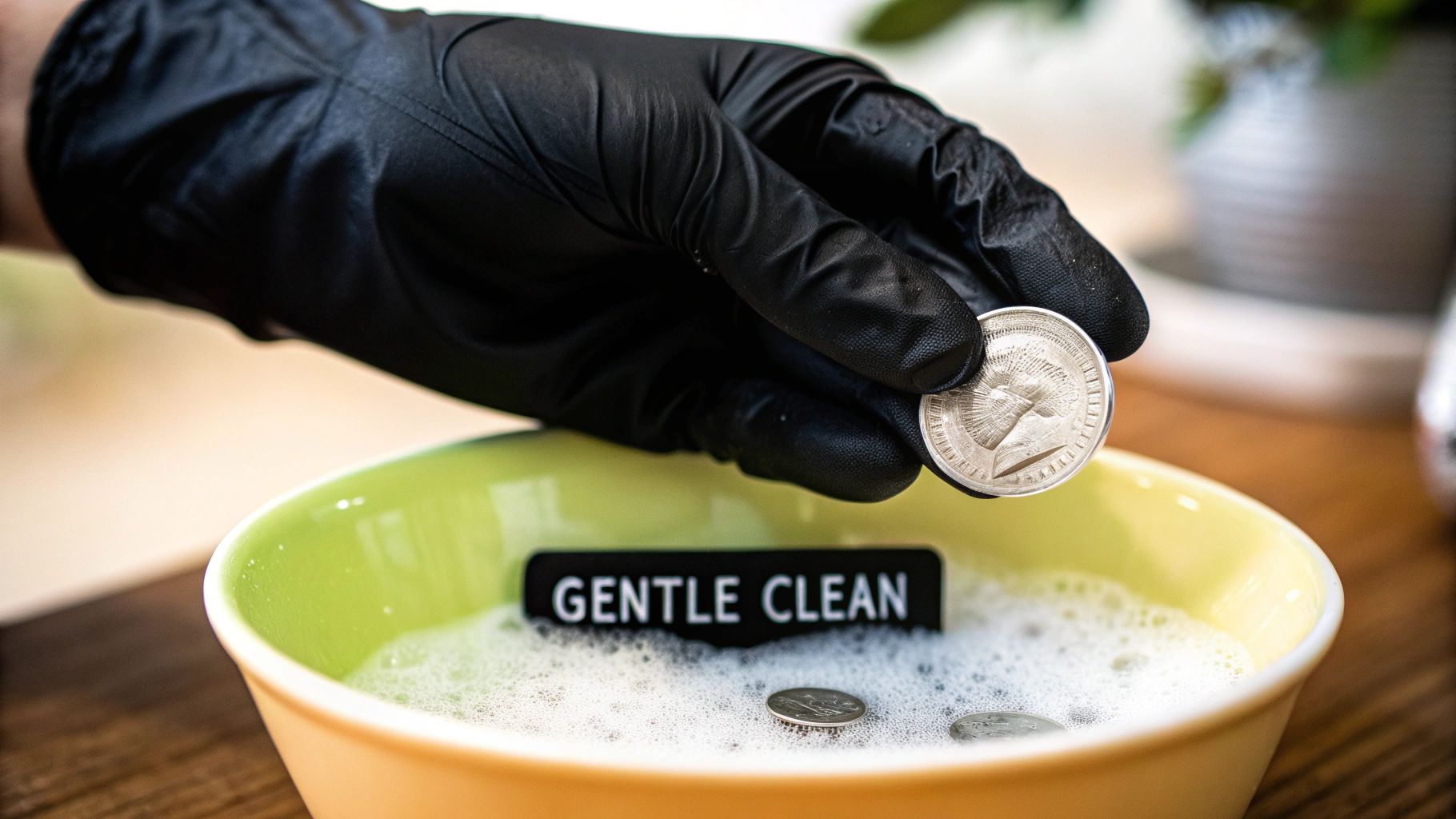
Before the 1980s, it wasn't just acceptable for collectors to polish their coins—it was often encouraged. Many guidebooks from that era actually recommended it as a way to "improve" a coin's appearance. The goal was a bright, shiny collection, and a little polish was seen as standard maintenance, not a cardinal sin.
The Rise of Professional Grading
Everything changed with the arrival of professional coin grading services in the mid-1980s. Organizations like PCGS (Professional Coin Grading Service) and NGC (Numismatic Guaranty Corporation) introduced a standardized, objective system for evaluating coins, and it completely revolutionized the market. This shift had a massive impact on how collectors viewed coin care.
These grading services started heavily penalizing coins that showed any signs of cleaning. Why the sudden change of heart? Because cleaning compromises the two things they value most:
- Original Surface: Any kind of abrasive cleaning, no matter how gentle you think you're being, creates microscopic scratches. These "hairlines" strip away the coin's original mint luster forever.
- Natural Patina: The toning that develops over decades is seen as a coin's historical fingerprint. It's proof of its authenticity and originality, a story told on its surface.
As soon as grading services started assigning lower grades—or flat-out refusing to grade cleaned coins—the market followed suit. A coin in its original, untouched state became far more valuable than a shiny, cleaned one.
This created a powerful economic incentive to leave coins alone. Suddenly, originality and natural toning became the key drivers of value. A collector who polished their rare silver dollar wasn't "improving" it anymore; they were actively destroying its numismatic premium.
This principle of authenticity driving value is universal, whether you're dealing with coins or other high-end collectibles. For instance, our guide on how to authenticate Rolex watches highlights very similar principles. Originality is king.
If you have gold, jewelry, or other collectibles, it's always best to get an expert opinion before you do anything. Here in Boise, you can find specialists in Gold and Jewelry Buying who offer the highest payout, Xray Scanning and Gold Testing for free, and hassle free offers with Price Matching. Save the hassle and sell locally for more than online shipments.
Get a Professional Evaluation Before You Clean
After exploring the history and the very real risks, the smartest path forward is often the simplest one: don't touch it. If you have even the slightest doubt about your silver dollar's origin, rarity, or potential numismatic worth, the absolute best move you can make is to get a professional opinion before you even think about cleaning it. A quick, well-intentioned polish could easily turn into a multi-thousand-dollar mistake.
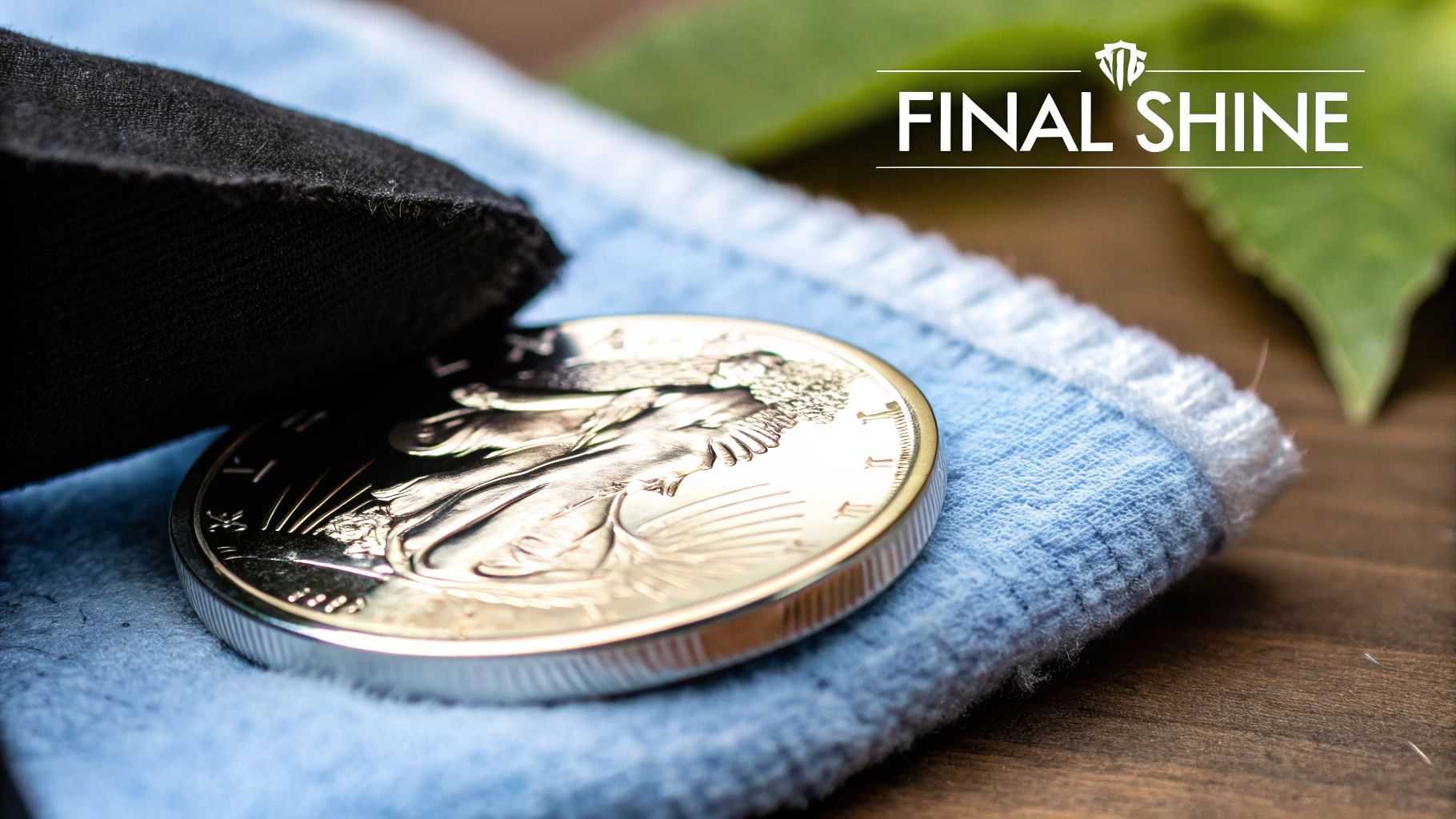
Instead of gambling with its value, consider a professional evaluation from a trusted local buyer. Here in Boise, our experts specialize in assessing entire collections of silver, gold, and fine jewelry, and we pride ourselves on providing transparent and hassle-free offers. We see these coins day in and day out, and we understand the subtle nuances that separate a common coin from a rare treasure.
Why a Local Expert Matters
Selling your valuables locally has some serious advantages over just mailing them off to some faceless online buyer. The whole process is safer, faster, and, frankly, often more profitable. You get to skip the stress and uncertainty of shipping precious items and walk away with an instant, secure payment.
We're committed to providing the highest payout in Boise, and we don't just say that—we stand by it with a Price Matching guarantee. Our goal is to make sure you feel confident and receive the maximum possible value for your items.
When you sell locally, you’re not just a tracking number. You get personalized service from experts who can explain your item's value face-to-face, answering your questions directly and transparently.
Our Non-Invasive Assessment Process
Getting a professional evaluation doesn't mean putting your coin at risk. We use state-of-the-art, non-damaging technology to determine the precise value and authenticity of your pieces. This isn't just a guy with a magnifying glass.
Our process includes:
- Free Xray Scanning: This technology lets us see the exact metallic composition of your silver dollars and other bullion without ever touching the coin's surface. No scratches, no chemicals, just pure data.
- Free Gold Testing: For any gold items you might have, we use advanced methods to accurately verify purity and weight. This is a core part of our Gold and Jewelry Buying service.
This tech-driven approach ensures we can provide a firm, competitive offer based on real data, not guesswork. It allows us to identify the true worth of your silver dollar, whether its value is tied to its metal content or its rarity as a collectible.
Before you make a move you might regret, let our team provide a complimentary, no-obligation evaluation. You might be surprised at what your collection is truly worth. Knowing the facts empowers you to make the best decision—whether that's keeping your coin, selling it for a top-tier price, or simply understanding its place in history. Save the hassle and sell locally for more than online shipments.
Of course. Here is the rewritten section, crafted to sound like it was written by an experienced human expert, following all your specific instructions and examples.
Your Burning Questions About Cleaning Silver Dollars
After covering the risks and safe handling, you probably still have some specific questions buzzing around in your head. It's only natural. Let's tackle some of the most common ones we hear from collectors and folks who've just inherited a box of old coins.
One of the first things people ask is, "Can I just use a little silver polish on my coin?" My answer is always an immediate and emphatic no. Commercial silver polishes are made for your grandma's silverware, not for the delicate, intricate surface of a coin. They're incredibly abrasive and will leave behind a web of micro-scratches, stripping away any natural patina and tanking its numismatic value for good.
Then comes the follow-up: "But what about the gunk stuck in the crevices?" My advice? Leave it be. What you see as "gunk" might actually be a part of the coin's history and natural aging process. If it's just some loose dust or debris, the absolute most you should ever consider is a quick, gentle rinse with distilled water. Don't rub it. Don't scrub it. Any friction is your enemy here.
So, Is It Ever Okay to Clean a Coin?
This is a tricky one. The short answer is: almost never. But there are a couple of rare exceptions.
Let's say you have a common-date silver dollar—nothing rare, no key dates—and it has active damage, like that nasty green gunk from being stored in an old PVC flip. In a case like that, a professional conservator might step in. This isn't "cleaning" like you'd imagine; it's a careful chemical process designed specifically to halt further corrosion. It's a rescue mission, not a polish job.
For the average person holding a coin, the only time you might consider a gentle method (like the one we discussed with baking soda) is for a common bullion piece. We're talking about a coin you own purely for its silver content and maybe its looks, with zero collector value attached.
Key Takeaway: Unless you're a trained professional, the risk of wrecking a potentially valuable coin is just too high. The reward of making it a bit shinier isn't worth it. When in doubt, do nothing at all.
What's My Coin's Story? Deciding What to Do Next
"Okay, so how do I know if my coin is valuable before I mess it up?" This is the single most important question you can ask. You can't be expected to become a numismatic expert overnight, and you don't have to.
The smartest move is always to get a professional evaluation. Don't guess, don't gamble. Get an expert opinion.
This is especially critical if you're thinking about selling. So many people make the mistake of trying to "spruce up" their coins or jewelry before showing them to a buyer. We actually want to see these items in their original, untouched state. The history is part of the value. For more great advice on presenting your items and sharing their story, check out our guide covering some top tips for successful blogging—you'd be surprised how many of the same principles of clear communication apply.
Our team specializes in Gold and Jewelry Buying. We use non-invasive technology like Xray Scanning and Gold Testing for free to figure out exactly what you have without leaving a single mark.
- We provide hassle free offers.
- We're committed to the highest payout in Boise.
- We even offer Price Matching to ensure you get the absolute best value.
Save the hassle and sell locally for more than online shipments. Let us take a look at your collection before you make a decision you can't undo.
At Carat 24 - Trusted Gold Experts, our goal is to give you the knowledge to make the best decisions for your collection. Stop by for a free, no-obligation evaluation of your coins, gold, and jewelry. https://carat24boise.com
